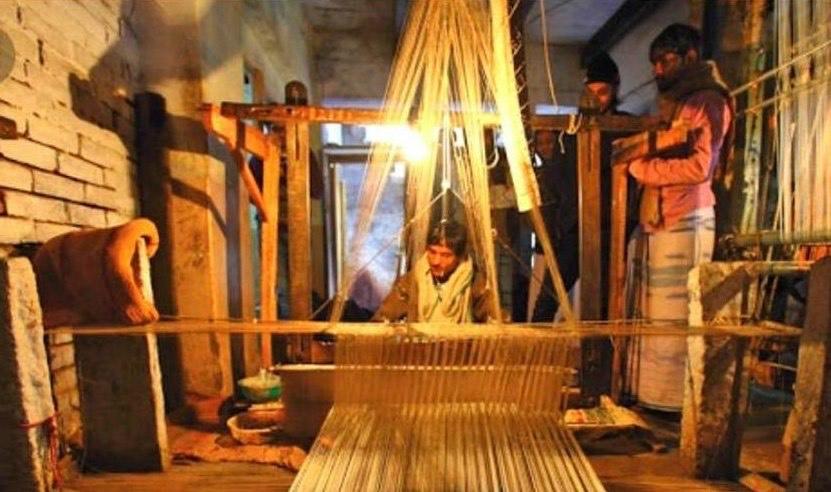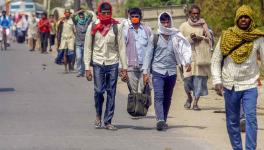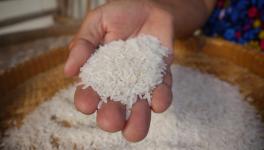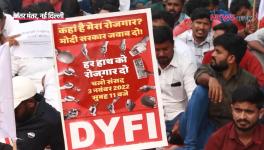Weavers of Eastern UP Lost Work During Pandemic, Received No Help From Govt, Says Study

89% of weavers from eastern UP could not or did not approach the local and state government for a variety of relief measures – food rations, monetary assistance, inflated electricity bills, sewage-related and other civic problems – during the COVID-19 pandemic because of trust deficit, found a report that was released by Citizens for Justice and Peace (CJP) on Monday, January 31. The remaining 11% of the weavers, who did approach the state government for help, were dissatisfied with the response.
The report is based on a sustained collaborative study lasting several months in 2020-2021, conducted by a dedicated team of well-trained on-ground researchers led by Dr Muniza Khan, a Varanasi-based scholar and qualified researcher in the social sciences. The fact-finding investigation team conducted as many as 204 detailed recorded interviews in Varanasi, Gorakhpur (Rasoolpur, Purana Gorakhnath), Azamgarh (Mubarakpur, Ibrahimpur, Shahpur) and Mau (Ghosi, Madhuban). The researchers spoke to people engaged in different aspects and stages of spinning together some of India's most exquisite textiles.
The report pointed out that the weavers do not have access to Central government schemes. The much-publicised Pradhan Mantri Ujjwala Yojana (PMUY) has not reached them. Only 10% of the women among those who were surveyed were even registered to get Ujjwala Gas under this scheme; the rest remain excluded, despite multiple attempts to apply for the same. The weavers also found Prime Minister Jan Dhan Yojana (PMJDY) challenging to access. A staggering 52% of the respondents did not have an account. Only 58% received cash transfers more than once among those who did.
The weavers who are wage workers or those who have just a few looms belong to communities like Muslim Ansari, Dalit, OBC and some are Muslims who hail from more privileged castes. "Today, a vast section of this artisanal industry is completely impoverished and invisible. Informed and reasoned public dialogue is needed to influence not just political but economic policy and decision making," the report said.
According to the researchers, there has been a loss of Rs 3,000 crore to Purvanchal's handicraft and handloom businesses because of the COVID-19 pandemic in Europe and UK. European countries import the most considerable amount of silk dress materials, Sarees, scarves, dupattas, bed sheets and cushion covers.
Rajan Bahal, general secretary of the Banarasi Vastra Udyog Sangh, told the researchers that traders are concerned given the second wave of Coronavirus in European countries. The orders that were received are being cancelled. Many traders have reduced their production, and many have stopped work. And the weavers have had to bear the brunt of this.
Weaving is the leading work when it comes to the loom industry. Before the lockdown, 120 of the male respondents from the survey, 77%, were involved in weaving work. After the lockdown, there was a drastic fall in this number. Only 40 men had work after lockdown, which is only 26%.
"Therefore, weaving as an activity was affected severely to the point that it effectively came to an end. Due to this, men started taking up whatever work they were getting, because of the pressures of a patriarchal society where they are considered to be the breadwinner of the family," the report said. Before the lockdown, only 3 (2%) men were working as labourers, but the number went up to 19 (12%) after lockdown. The men's other work in the loom industry includes binding, finishing, dyeing, making patta (draft design) and embroidery. In all these weaving related activities, the number of men involved before the lockdown was 19 (12%), and after lockdown, it declined to 10 (6%).
Zari/Zardozi is different from weaving; it is mainly hand embroidery. As per the survey, 19 (12%) men were involved in Zari and Aari work, and after lockdown, the number declined to 13 (8%). Before the lockdown, 4 (2.5%) of the men had their shops, and after lockdown, only 2 (1%) of the men had their shops. 20 (13%) men were involved in some other work before lockdown, and the number increased to 23 (15%) after lockdown. The occupations of these men include working at someone else's shop, daily-wage labour, auto-rickshaw driving, carpentry, running a tea stall etc. There were 6 (4%) weavers who had no work after the lockdown.
The women workers faced even worse troubles. 8 (16%) of the women surveyed were involved in weaving before the lockdown, but there is not a single woman working on the loom after it. The report said that women working in this industry are most affected by this pandemic. The data collected by the researchers showed that 25 (51%) women did not have any work after the lockdown, whereas before lockdown, only 3 (6%) women had no work.
Total 165 (81%) families out of the real 204 interviewees have ration cards, out of which 145 (88%) families have a white ration card. White ration cardholders get 5 kg foodgrains (2 ½ kg rice and 2 ½ kg wheat) every month per unit at Rs 2 per kg for wheat and Rs 3 per kg for rice. 8 (5%) families have a red ration card. These are the poorest sections covered under the Antodaya Anna Yojana and get 5 kg food grains per unit every month free of cost. 12 (7%) families have yellow ration cards. These ration card holders are above the poverty line, and hence they are not entitled to PDS.
During lockdown in April 2020, the government had announced a scheme where people will get ration twice a month, the first time they will get free (wheat, rice and 1 kg Chana) and the second time people will have to purchase at the usual rates and this scheme was going to be implemented for eight months.
Out of the 165 families who have ration cards, only 111 (67%) families got ration twice during lockdown; the first time, it was given for free, and the second time they had to purchase. Here also, there were alleged loopholes in the implementation of the scheme. People only got this for the first 5-6 months, whereas according to the scheme, they were supposed to get it till November, 2020.
The report pointed out that the distribution of foodgrains also differed from place to place. "At some places, people got ration as little as 1 or 2 kgs and in some places, people got as much as 51 kgs! So, there was no uniformity in the PDS, and there were allegations of corruption. People also complained that shopkeepers sometimes don't give the assigned unit per member, keeping the difference for sale at regular prices. As a result, the neediest people got less ration from the ration shop during the lockdown," it said.
The report said, "The impact on the complex, multi-tiered and interdependent structure of the weaving industry is at one level, simple enough to comprehend. The bottom-most layer of loomless weavers, i.e. wage workers (both handloom and power loom), are understandably the worst hit during the lockdown. But the impact of the pandemic and lockdown has had a snowballing effect on the entire industry. The entire industry came to a standstill, and the various relief measures presumably intended for the people did not reach most of those who were the neediest."
Get the latest reports & analysis with people's perspective on Protests, movements & deep analytical videos, discussions of the current affairs in your Telegram app. Subscribe to NewsClick's Telegram channel & get Real-Time updates on stories, as they get published on our website.
























